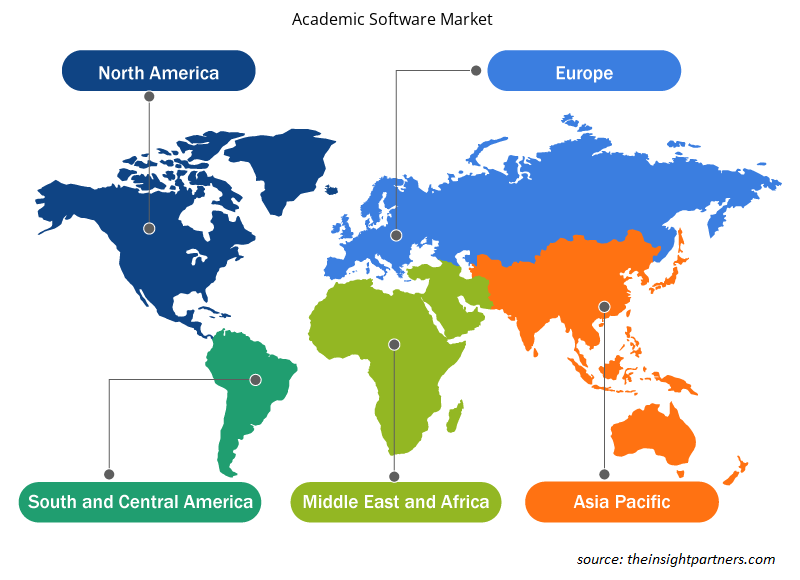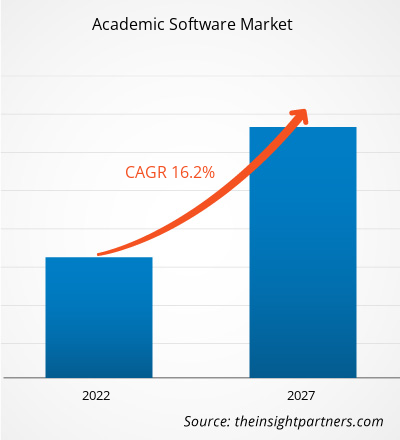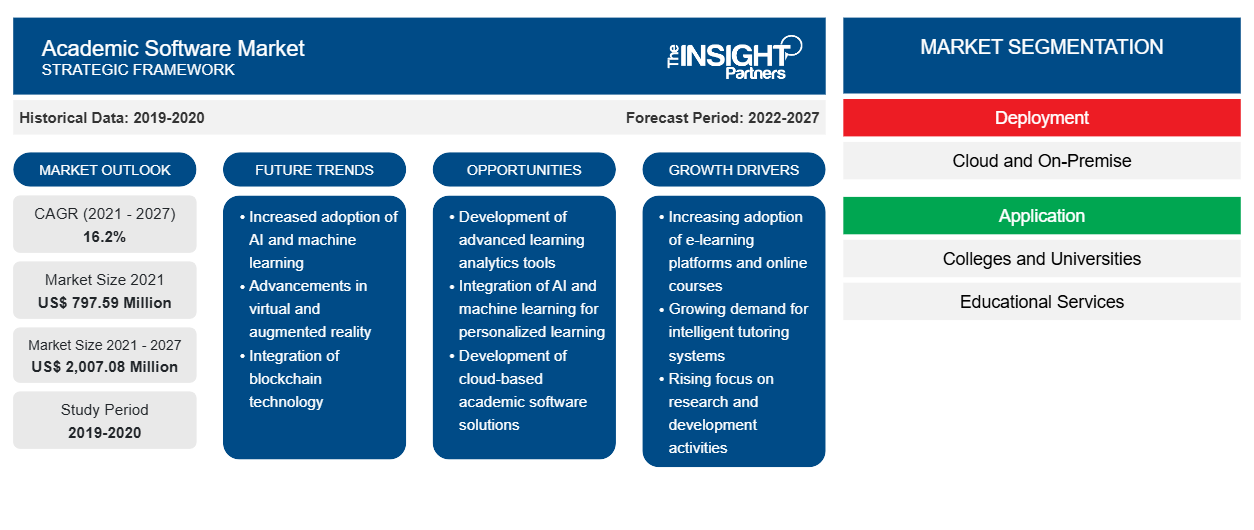Der Markt für akademische Software soll von 797,59 Millionen US-Dollar im Jahr 2021 auf 2.007,08 Millionen US-Dollar im Jahr 2027 wachsen. Im Prognosezeitraum von 2021 bis 2027 wird für den Markt für akademische Software eine durchschnittliche jährliche Wachstumsrate (CAGR) von 16,2 % erwartet.
Die zunehmende Verbreitung von eLearning in allen Institutionen ist der Schlüsselfaktor für das Wachstum des Marktes für akademische Software. Beim eLearning verändert sich durch das Lesen oder Ansehen von Inhalten die Art und Weise, wie Bildung vermittelt wird. Mehrere eLearning-Kurse wie Animationen, Podcasts und Videos schaffen eine multimodale und realistische Lernumgebung. ELearning-Bildungsinhalte eröffnen Lernenden über Computer, Laptops, Tablets oder Smartphones mehrere Möglichkeiten des immersiven Lernens. Anstatt sich in einer passiven Umgebung zu befinden, können die Studierenden einfach und schnell auswählen, was sie lernen möchten. Diese Vorteile erhöhen die Nachfrage nach akademischer Software auf der ganzen Welt.
Die COVID-19-Pandemie hat den Bildungssektor weltweit schwer getroffen. Dies hat auch die Einführung von Online-Bildungssystemen in allen großen Volkswirtschaften der Welt gefördert und damit die Einführung von Software für verschiedene Anwendungen beeinflusst, z. B. das Halten von Vorlesungen, die Verwaltung von Studenten und andere betriebliche Aktivitäten von entfernten Standorten aus. Daher wird erwartet, dass sich die zunehmende Einführung technologisch fortschrittlicher Lösungen im gesamten Sektor positiv auf das Wachstum des Marktes für akademische Software während der Pandemie auswirken wird.
Basierend auf der Bereitstellung ist der Markt für akademische Software in Cloud und On-Premise unterteilt. Im Jahr 2019 hatte das Cloud-Segment einen höheren Marktanteil. In den letzten Jahren hat die Technologiebranche einen stetigen Anstieg der Nutzung von Cloud-basiertem Computing erlebt. Dies ist auf die Tatsache zurückzuführen, dass Cloud-basiertes Computing die Implementierungszeit vereinfacht und die Bereitstellungskosten erheblich senkt. Dieser Vorteil hat eine große Anzahl von Endbenutzern angezogen; daher liefert die Mehrheit der Akteure auf dem Markt für akademische Software Cloud-basierte Produkte in Verbindung mit der wachsenden Nachfrage nach Cloud-basierter Software. Darüber hinaus hat sich die Internet-Infrastruktur in Industrieländern weiterentwickelt und floriert in vielen Entwicklungsländern, sodass Endbenutzer sowohl in Industrie- als auch in Entwicklungsländern auf Cloud-basierte Lösungen zugreifen können.
Passen Sie diesen Bericht Ihren Anforderungen an
Sie erhalten kostenlos individuelle Anpassungen an jedem Bericht, einschließlich Teilen dieses Berichts oder einer Analyse auf Länderebene, eines Excel-Datenpakets sowie tolle Angebote und Rabatte für Start-ups und Universitäten.
-
Holen Sie sich die wichtigsten Markttrends aus diesem Bericht.Dieses KOSTENLOSE Beispiel umfasst eine Datenanalyse von Markttrends bis hin zu Schätzungen und Prognosen.
Einblicke in den Markt für akademische Software
Integration von Technologien wie künstlicher Intelligenz in akademische Softwarelösungen
Künstliche Intelligenz (KI) ist eine Technologie, die Computern die Fähigkeit verleiht, auf die gleiche Weise wie Menschen mit anderen zu kommunizieren, Ereignisse zu verstehen, zu lernen und auf Ereignisse zu reagieren. Im Laufe der Jahre wurde künstliche Intelligenz nicht nur in zahlreichen Branchen wie Sicherheit, Überwachung und Informationstechnologie eingesetzt, sondern auch im Bildungssektor immer häufiger eingesetzt. KI wird in Schulen, Colleges und Universitäten eingesetzt, um sich wiederholende Aufgaben wie Benotung, Finanzanalyse und Zulassungsverfahren zu automatisieren. Beispielsweise kann KI so kalibriert werden, dass sie die Aktionen der Lehrer bei der Benotung lernt und modelliert, und zwar mithilfe fortschrittlicher Computerprogramme wie Automated Grading, um in Zukunft automatisch Noten zu vergeben. Mit der Zeit lernt das Programm die akademischen Fähigkeiten mehrerer Schüler und erstellt auf der Grundlage ihrer Leistungen individuelle Trainingspläne.
Bereitstellungsbasierte Markteinblicke
Basierend auf der Bereitstellungsart ist der globale Markt für akademische Software in Cloud und On-Premise segmentiert. Cloudbasierte akademische Software erfährt im Vergleich zu On-Premise-Akademiesoftware eine hohe Nachfrage. Das Cloud-Segment generiert den Großteil der Nachfrage, da es aufgrund der starken Netzwerkinfrastruktur in Industrieländern vergleichsweise weniger teuer ist. Darüber hinaus konzentrieren sich die Anbieter cloudbasierter akademischer Software stark auf die Entwicklung eines hochrangigen Sicherheitspatches, um das Risiko von Cyberangriffen auszuschließen. Dieser Faktor erzeugt auch eine erhebliche Nachfrage seitens der Endbenutzer und treibt damit den Markt für akademische Software an.
Anwendungsbasierte Markteinblicke
Basierend auf der Anwendung ist der Markt für akademische Software in Hochschulen und Universitäten, Bildungsdienste und andere unterteilt. Die zunehmende Einführung moderner Lösungen in Bildungseinrichtungen und Universitäten, um Studenten sowohl Online- als auch Offline-Kurse anzubieten, gepaart mit der Initiative, allen Mitarbeitern und Studenten fortschrittliche Lösungen zur Verfügung zu stellen, beeinflusst die Einführung akademischer Software. Dies treibt das Wachstum des Marktes im Laufe der Jahre voran.
Akteure auf dem Markt für akademische Software konzentrieren sich auf Strategien wie Marktinitiativen, Akquisitionen und Produkteinführungen, um ihre Position auf dem Markt für akademische Software zu behaupten. Einige Entwicklungen der wichtigsten Akteure auf dem Markt für akademische Software sind:
Im Dezember 2020 führte die Alma-Plattform für Studenteninformationssysteme die Funktion „Notendurchschnitte“ (GPA) ein, die dem Notenbuch-Tool hinzugefügt wurde. Die standardbasierte Benotung (SBG) basiert darauf, das Feedback und die Fortschrittsmessung der Studenten an den jeweiligen Fähigkeiten auszurichten, die gelehrt und bewertet werden, anstatt eine einzige Punktzahl für mehrere Themen oder Standards zu verwenden.
Im Juli 2020 hat ConexED seine iOS-App 2.2.3 für eine benutzerfreundlichere Erfahrung aktualisiert. Mit dieser App können Studierende, Mitarbeiter und Lehrkräfte auf ihren Mobilgeräten an virtuellen Meetings und Videokonferenzen teilnehmen.
Regionale Einblicke in den Markt für akademische Software
Die regionalen Trends und Faktoren, die den Markt für akademische Software im Prognosezeitraum beeinflussen, wurden von den Analysten von Insight Partners ausführlich erläutert. In diesem Abschnitt werden auch die Marktsegmente und die Geografie von akademischer Software in Nordamerika, Europa, im asiatisch-pazifischen Raum, im Nahen Osten und Afrika sowie in Süd- und Mittelamerika erörtert.

- Erhalten Sie regionale Daten zum Markt für akademische Software
Umfang des Marktberichts für akademische Software
| Berichtsattribut | Details |
|---|---|
| Marktgröße im Jahr 2021 | 797,59 Millionen US-Dollar |
| Marktgröße bis 2027 | 2.007,08 Millionen US-Dollar |
| Globale CAGR (2021 - 2027) | 16,2 % |
| Historische Daten | 2019-2020 |
| Prognosezeitraum | 2022–2027 |
| Abgedeckte Segmente |
Nach Bereitstellung
|
| Abgedeckte Regionen und Länder |
Nordamerika
|
| Marktführer und wichtige Unternehmensprofile |
|
Dichte der Akteure auf dem Markt für akademische Software: Die Auswirkungen auf die Geschäftsdynamik verstehen
Der Markt für akademische Software wächst rasant, angetrieben durch die steigende Nachfrage der Endnutzer aufgrund von Faktoren wie sich entwickelnden Verbraucherpräferenzen, technologischen Fortschritten und einem größeren Bewusstsein für die Vorteile des Produkts. Mit der steigenden Nachfrage erweitern Unternehmen ihr Angebot, entwickeln Innovationen, um die Bedürfnisse der Verbraucher zu erfüllen, und nutzen neue Trends, was das Marktwachstum weiter ankurbelt.
Die Marktteilnehmerdichte bezieht sich auf die Verteilung der Firmen oder Unternehmen, die in einem bestimmten Markt oder einer bestimmten Branche tätig sind. Sie gibt an, wie viele Wettbewerber (Marktteilnehmer) in einem bestimmten Marktraum im Verhältnis zu seiner Größe oder seinem gesamten Marktwert präsent sind.
Die wichtigsten auf dem Markt für akademische Software tätigen Unternehmen sind:
- Alma
- CAMPUS CAFÉ SOFTWARE
- ConexED
- Envisio Solutions Inc.
- VOLLSTÄNDIGER STOFF
Haftungsausschluss : Die oben aufgeführten Unternehmen sind nicht in einer bestimmten Reihenfolge aufgeführt.

- Überblick über die wichtigsten Akteure auf dem Markt für akademische Software
Markt für akademische Software – nach Bereitstellung
- Wolke
- Vor Ort
Markt für akademische Software – nach Anwendung
- Hochschulen und Universitäten
- Bildungsdienstleistungen
- Sonstiges
Markt für akademische Software – nach Geografie
-
Nordamerika
- UNS
- Kanada
- Mexiko
-
Europa
- Frankreich
- Deutschland
- Russland
- Vereinigtes Königreich
- Italien
- Restliches Europa
-
Asien-Pazifik (APAC)
- China
- Indien
- Japan
- Australien
- Südkorea
- Restlicher Asien-Pazifik-Raum
-
MEA
- Saudi-Arabien
- Vereinigte Arabische Emirate
- Südafrika
- Rest von MEA
-
SAM
- Brasilien
- Argentinien
- Rest von SAM
Markt für akademische Software – Firmenprofile
- Alma
- CAMPUS CAFÉ SOFTWARE
- ConexED
- Envisio Solutions Inc.
- VOLLSTÄNDIGER STOFF
- PowerVista Software, Inc.
- Qualtrics LLC
- Tophatmonocle Corp
- TrueDialog
- WizeHive
- Historische Analyse (2 Jahre), Basisjahr, Prognose (7 Jahre) mit CAGR
- PEST- und SWOT-Analyse
- Marktgröße Wert/Volumen – Global, Regional, Land
- Branchen- und Wettbewerbslandschaft
- Excel-Datensatz
Aktuelle Berichte
Verwandte Berichte
Erfahrungsberichte
Grund zum Kauf
- Fundierte Entscheidungsfindung
- Marktdynamik verstehen
- Wettbewerbsanalyse
- Kundeneinblicke
- Marktprognosen
- Risikominimierung
- Strategische Planung
- Investitionsbegründung
- Identifizierung neuer Märkte
- Verbesserung von Marketingstrategien
- Steigerung der Betriebseffizienz
- Anpassung an regulatorische Trends























 Kostenlose Probe anfordern für - Markt für akademische Software
Kostenlose Probe anfordern für - Markt für akademische Software